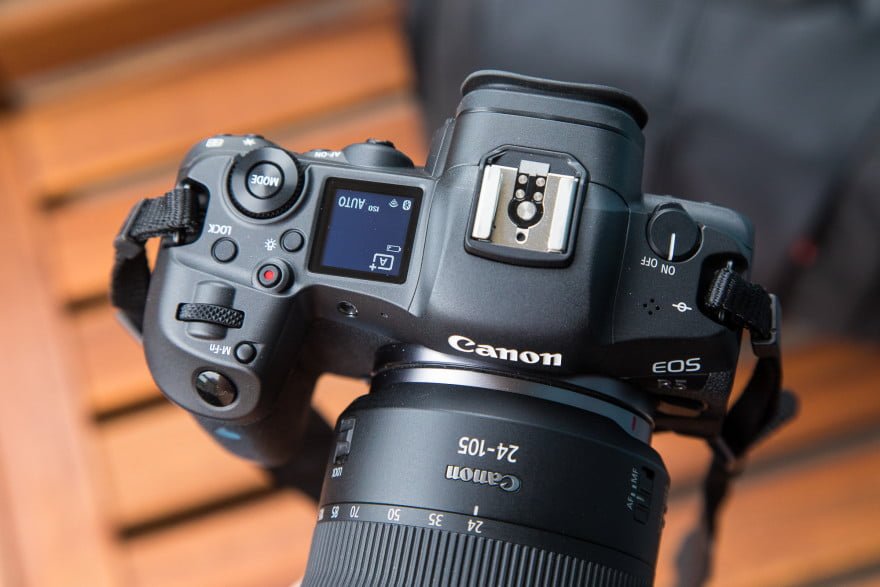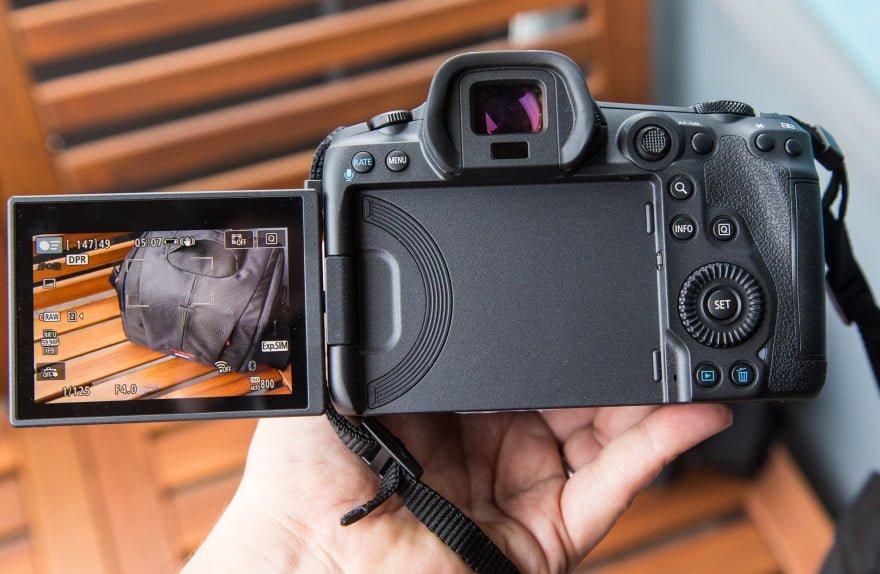The Canon EOS R5 is the best camera that I’ve ever used. The build is sturdy, it’s fast and packed with features, and the images are crisp, true-to-life, and dazzling.
With the camera’s 45 MP full-frame sensor, that captures 35.4 MP images, it felt a bit like rediscovering photography because there’s just so much you can try, especially with the RF 24-105mm lens available with the camera, if you buy it as a kit.
Camera Body, Build & Controls

I’ve been shooting Canon for over a decade, and coming from my 5D Mark IV, the R5 feels familiar, and also like an upgrade. The R5 follows all the design styles you expect from an EOS camera, with a few new elements.
Because it’s mirrorless, it’s a little bit lighter than the 5D Mark IV, and number of buttons and dials have been moved around. For instance, on the top of the camera, the power switch is the only thing on the left side of the hot shoe, and the settings display has been shrunk from the 5D to make room for the mode dial and the video record button.
It took some getting used to, because I shoot so much with the 5D, and I only had two weeks to get used to the R5, but it felt very natural by the end of the review period.
Overall, the design works very well, and I like how straightforward it is to handle.
The only complaint I’d level about the design would be the 3.15″ touchscreen LCD display. It looks great, and it’s easy to use, but you can’t always get it to the perfect angle, depending on how you’re shooting, and the arm feels like it could be sturdier.
I never had an issue, aside from trying to get the right angle sometimes, however I would be extra cautious of the display when it’s not flat against the camera. The display was good though, bright enough for indoors and outdoors, and with good touch sensitivity.
Otherwise the magnesium body is excellent, and the camera is dust- and water-resistant, so it will stand up to some exposure to water drops and dirt.
Image Quality & Features
%22%20transform%3D%22translate(1.7%201.7)%20scale(3.4375)%22%20fill-opacity%3D%22.5%22%3E%3Cellipse%20fill%3D%22%23a09fa5%22%20rx%3D%221%22%20ry%3D%221%22%20transform%3D%22matrix(-11.59569%20-64.60518%2037.72588%20-6.77125%2086.2%2098.5)%22%2F%3E%3Cellipse%20fill%3D%22%23263000%22%20cx%3D%22185%22%20cy%3D%2213%22%20rx%3D%2272%22%20ry%3D%2272%22%2F%3E%3Cellipse%20fill%3D%22%23a6a4b4%22%20rx%3D%221%22%20ry%3D%221%22%20transform%3D%22matrix(-4.80693%20-31.07312%2052.4449%20-8.1131%20250.2%20112.2)%22%2F%3E%3Cellipse%20fill%3D%22%23222030%22%20rx%3D%221%22%20ry%3D%221%22%20transform%3D%22matrix(-39.61792%20216.19056%20-24.70482%20-4.52727%2013.7%2060.6)%22%2F%3E%3Cellipse%20fill%3D%22%234d5d00%22%20cx%3D%22144%22%20cy%3D%2252%22%20rx%3D%2243%22%20ry%3D%2243%22%2F%3E%3C%2Fg%3E%3C%2Fsvg%3E)
Canon EOS R5 image – Toronto lakeshore %22%20transform%3D%22translate(1.7%201.7)%20scale(3.4375)%22%20fill-opacity%3D%22.5%22%3E%3Cellipse%20fill%3D%22%23e3f6fe%22%20rx%3D%221%22%20ry%3D%221%22%20transform%3D%22matrix(76.19627%20-16.25616%2012.05047%2056.48326%20224.6%2040.6)%22%2F%3E%3Cellipse%20rx%3D%221%22%20ry%3D%221%22%20transform%3D%22matrix(69.67466%20-95.19835%2048.8476%2035.75103%2041.3%2036.4)%22%2F%3E%3Cellipse%20fill%3D%22%230f0f0c%22%20rx%3D%221%22%20ry%3D%221%22%20transform%3D%22matrix(-51.32117%2083.43893%20-26.7179%20-16.4335%2030.3%2039)%22%2F%3E%3Cellipse%20fill%3D%22%23979898%22%20cx%3D%22234%22%20cy%3D%22169%22%20rx%3D%2280%22%20ry%3D%2230%22%2F%3E%3Cellipse%20fill%3D%22%23d9d0cc%22%20rx%3D%221%22%20ry%3D%221%22%20transform%3D%22rotate(2.5%20-1063.8%205343.5)%20scale(56.3277%2029.67021)%22%2F%3E%3C%2Fg%3E%3C%2Fsvg%3E)
Canon EOS R5 image – Toronto CN tower view
Looking at any of the images I shot with the R5, it’s easy to call this Canon’s best camera ever. The image quality is crisp, clear, vibrant, and there are endless features to help you capture almost anything you want to shoot.
At the top of my favourite features is the in-body image stabilization (IBIS). While you’re shooting, the stabilizer inside the camera reduces shake and movement with the lens by moving the sensor, which really cuts down on blurry images, even at lower shutter speeds while you’re moving and shooting.
From shooting portraits, landscapes, action shots, and trying out a range of things, I was impressed with how well it handled overall. The DIGIC X image processor helps create really incredible details, clarity, and with an overall lack of noise at a range of settings. The focus is also incredibly fast, especially compared to a standard DSLR.
Testing out the shooting speed, you can get up to 20 frames-per-second for action shots, and fast-moving subjects from kids to cars.
The new Dual Pixel CMOS AF II features 1,053 automatic AF zones, so it’s also possible to very quickly capture a shot with all the important details in focus. The camera recognizes a range of subjects, like faces, to help capture better photos at a moment’s notice.
As far as the ISO goes, the R5 gets gorgeous results from ISO 50 all the way to ISO 6400, with a little more noise the higher you go. You can push beyond 6400, and the R5 shoots up to ISO 51200, but images do get progressively noisier.
Looking at the available RF lenses for the R5, there are a few already, and there are sure to be a lot more over time as mirrorless becomes the norm. If you’re already a Canon shooter, you can buy an RF adapter to bring over your favourite EF and EF-S lenses, and it works well.
Video

8K video is going to be on a lot of people’s minds going forward, and the R5 uses the full sensor to capture full-frame video that’s very impressive. There are some limitations though, and some other things to keep in mind, including for 4K video shooting.
With a fresh battery, you will get about 20 minutes of 8K footage, and the camera will also need to cool down afterwards. The files sizes are also relatively huge, and you’ll need to buy an expensive CFexpress card to shoot in 8K.
Since I didn’t have a CFexpress card when I was testing the camera, I was only able to do a few tests for 8K video. I was definitely blown away by the quality, but the limitations do make it difficult to recommend for most users. Hopefully a firmware update can help address some of the issues, and get 8K to work a little better.
On the other hand, 4K video with the R5 was a fantastic experience. In 4K you can capture up to 120 FPS–although that requires the CFexpress card too–or 4K 60 FPS, and the video quality still looks amazing.
Compared to other 8K cameras, it’s a bit harder to recommend the R5 for video, but the option is available and I’d say it’s a great extra for some shooters. At lower speeds and resolution, the camera doesn’t heat up at all either, so it’s excellent for 4K shooting.
Battery Life, Ports & Wi-Fi

When it comes to battery life, the R5 lasts well for photos, but does drain a little faster if you’re shooting video, particularly above 60 FPS or 4K. I would recommend heavy shooters will need three batteries if they plan to shoot for a few hours or capture a lot of video, but that’s an investment I’d recommend with most cameras.
The wireless file transfer from the camera, and remote control using the Canon app, were both incredibly fast and easy. Compared to my 5D Mark IV, the R5 is much quicker, thanks to the Bluetooth support, and offers both 2.4 GHz Wi-Fi and 5 GHz.
For the ports, you get everything you would hope for, which is comparable to the recent Canon cameras, including USB-C, HDMI micro out, microphone, and headphone.
Finally, keep in mind that there is no CF card support for the Canon EOS R5. The camera works with CFexpress and SD/SDHC/SDXC memory cards, since they offer the best speed for shooting and especially video. For pros who may have a number of CF cards, that may be disappointing, but the speed of the newer SD cards definitely makes the upgrade worthwhile.
Overall
The Canon EOS R5 is priced at $5399.99 and while it’s an expensive mirrorless camera, it’s Canon’s best to date. At some point, this is absolutely the camera I’ll buy when I upgrade to mirrorless, and I’d recommend it for photographers who need the extra megapixels, speed, in-body image stabilization, and advanced AF zones.
Join our list
Subscribe to our mailing list and get weekly updates on our latest contests, interviews, and reviews.





